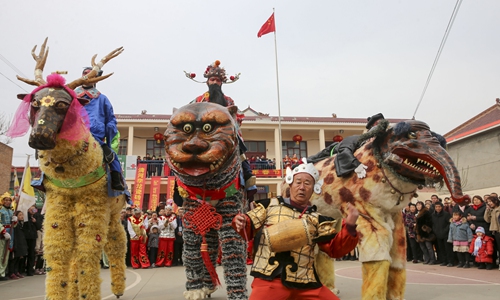HOME >> ARTS
Welcome to experience Chinese New Year in Pingyao, Shanxi Province
Source:Global Times Published: 2020/1/16 17:50:22

People make tiger-shaped huamo steamed buns in Yuncheng on June 5, 2019. Photo: CNSphoto
Chinese New Year in North China's Shanxi Province kicks off a tad earlier than in other places around China. While most places begin the Spring Festival holiday on the last day of the 12th month of the Chinese calendar, Chinese New Year's Eve, Shanxi starts off on the 23rd day of the 12th month of the Chinese calendar, which is Friday.Over the next 23 days, various activities are held each day such as preparing Spring Festival snacks for their family to enjoy when they gather together and attending parades.
According to local beliefs, as people celebrate the arrival of another year on Earth, up in Heaven the gods gather together to give their annual reports on their duties and after that hold their own celebratory banquet.
This is why that during this time people have come up with many methods to please the gods including offering delicious dishes and holding shehuo, a Chinese-style parade.
Pingyao food
Pingyao, a county in Shanxi renowned for its well-preserved Ming Dynasty (1368-1644) and Qing Dynasty (1644-1911) buildings, has already started preparing for the Spring Festival.
Decorated steamed buns, or huamo, are a necessary part of the ritual actiVities that take place around the Chinese New Year.
On Chinese New Year's Day (January 25 this year) in Pingyao, people pray to their ancestors and the gods in the morning and at noon. For the ceremony, more than 12 kinds of these buns need to be set on the table.
After the ritual, each of these buns, which are made into different shapes, are given to certain people such as young children and married women as a kind of blessing for the new year.
The buns are mainly made from white flour with other ingredients such as beans, dates, rice and pepper. When a bun is steamed, the chef uses various molds to imprint vivid images on them such as flowers, fish or birds. Sometimes ornaments are pasted on the buns using rice and beans, while food coloring is used for the many colors they come in.
The first dinner in Pingyao must have 12 dishes representing the 12 months of the year. Four of these 12 dishes are cold, four are vegetable dishes and the remaining four contain steamed or fried meat.
Of course, dumplings cannot be left off the menu for Chinese New Year. Chinese people believe that eating dumplings on this significant day is sure to put them in a good mood.

Performers hold a parade in Yuncheng, North China's Shanxi Province on February 16, 2019. Photo: CNSphoto
Chinese-style carnivalOn the first day of the Chinese New Year, the streets in Pingyao are almost empty as most residents are busy visiting relatives and friends to wish them a happy new year.
However, the situation is completely different on the 15th day of the first month, February 8 this year, because this is the day of the Lantern Festival. According to custom, people wearing brand new clothes and head out from home for a walk with friends to enjoy the very end of the happy New Year holiday.
Shehuo is a popular event during the Lantern Festival. It features a variety of folk arts.
Local people hang colorful lanterns and build stages on the main streets of towns around the county for parades and street performances.
Various traditional folk artists perform dragon and lion dances and Jinju Opera, as well as the yangko dance, which sees dancers queue up in a line and dance through the streets.
Wearing colorful makeup and gorgeous costumes, performers tell auspicious stories and send their best wishes to audiences.
Newspaper headline: Extended holiday
RELATED ARTICLES:
Posted in: CULTURE & LEISURE,ARTS FOCUS